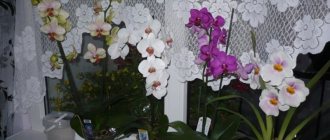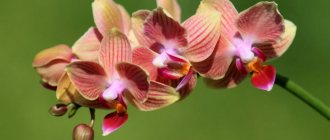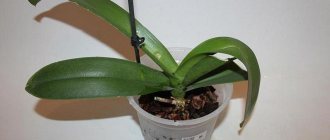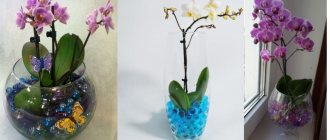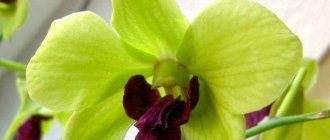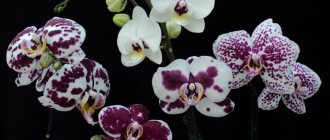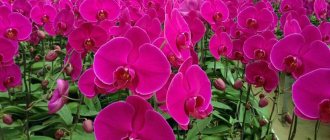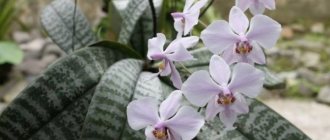Plants » Flowers
0
1461
Article rating
Kira Stoletova
Almost all types of orchids have the same set of organs: leaves, stem, aerial roots, bulbs (pseudobulbs), flowers. The pseudobulb of an orchid can tell a lot.
Pseudobulb in an orchid: what is it?
What it is?
The name "bulb" comes from the Latin word bulbus, which means "onion" . This organ is a thickening at the base of the orchid shoot, which stores water and nutrients. In many types of orchids, the bulb actually resembles a bulb in appearance, but this is far from the only variant of the form; bulbs can also be:
- round;
- ovoid;
- flat;
- cylindrical;
- fusiform;
- conical.
ATTENTION : The size of orchid bulbs is also very diverse: from a few millimeters to 15 centimeters, depending on the genus and species.
Only sympoidal orchids have bulbs . These orchids with numerous side vertical stems “can afford” to grow special storage organs from several shoots. Monopoidal orchids have only one stem, side stems rarely grow, so they actually have nothing to form bulbs from. Their moisture accumulates in thick, fleshy leaves.
How to care for an above-ground tuber?
As it turned out, the bulb retains moisture for the plant. This means that these types of orchids can develop for a long period of time without watering. This period of time in an orchid is called the dormant period. This phenomenon occurred due to severe droughts in their homeland. At the time of which, plants developed at the expense of previously accumulated resources.
Therefore, first of all, it is necessary to provide complete care for the orchid bulb. To do this you need:
- Maintain the temperature in the room. Bulbs prefer low temperatures.
- Full lighting. Pseudobulbs, like the plant itself, love bright light.
- Watering. It is necessary to water only when the pseudobulb begins to wrinkle. With regular watering, I will break the dormancy regime and the plant will die.
- Fertilizer. This should be done once every 3-4 weeks. Fertilize the bulb and substrate with special mineral fertilizers.
Don't water too often. This type of plant tolerates drought better than waterlogging.
As it turns out, not every type of orchid has pseudobulbs . But only those that are grown in natural conditions. The plant needs them in order to prevent the evaporation of moisture and participate in the photosynthesis of the flower. But by following all the rules for caring for an orchid, pseudobulbs reduce their functions.
For the full development of the plant, it is necessary to provide bright lighting and proper watering. But it is worth noting that this type of plant tolerates drought better than heavy moisture.
Photo
Below you can see the bulbs and pseudobulbs in the photo.
Cambria orchid species
Popular varieties of Cambria orchid:
| View | Crossed species | Flower/blooming period |
| Vuilstekeara | Cochlioda, Miltonia, Odontoglossum. | There are from 5 to 20 large buds on one peduncle. They come in pink, red, yellow shades. Late February - early March, lasts eight weeks. |
| Burrageara | Oncidium, Cochlioda, Miltonia, Odontoglossum. | Reddish and yellowish tones. They emit a pleasant aroma reminiscent of a rose. Starts in January. |
| Beallara | Brassia, Cochlioda, Miltonia, Odontoglossum. | Beige or pinkish-white-purple with dots and spots of darker tones. From July to the end of August. |
| Colmanara | Oncidium, Miltonia, Odontoglossum. | Various tones of red and yellow. Lasts from late winter to early summer. |
| Degarmoara | Brassia, Miltonia, Odontoglossum. | They grow up to 10 cm, have different shapes and shades. Starts at any time of the year. |
| Odontocidium | Mix of Oncidium, Odontoglossum. | Up to 50 medium-sized flowers in red, orange and yellow shades bloom on elongated stalks. There are dark spots and patterns on the surface of the petals. Any month. |
| Odontioda | Cochlioda, Odontoglossum. | Yellowish and reddish tones. Any month of the year. |
What are the differences between true and false?
Strictly speaking, there are no differences between the bulb and pseudobulb : they are the same organ, and the difference in names is a terminological convention. Traditionally in botany, the word “bulb” is used to refer to formations that have the shape of an onion, and the word “pseudobulb” refers to formations of any other shape. However, if you confuse the names, it will not be a serious mistake.
There are other, more universal terms:
- tuberidium;
- aerial tuber;
- pseudobulb.
The difference from real bulbs and tubers is that tubers and bulbs are located underground, and bulbs are located above its surface . Strictly speaking, orchids, in principle, rarely take root in the soil, preferring to grow on stones and trees, which are used as “stands”.
IMPORTANT : Many types of orchids grow on trees, but they are not parasites; they receive all the necessary nutrients during photosynthesis, as well as from litter (leaves, fallen bark).
These plants absorb moisture from the air: thick fogs and rain are not uncommon in the tropics. The presence of bulbs is direct evidence of the non-parasitic lifestyle of orchids; true parasites that feed on the host plant (for example, rafflesia) do not need to make reserves.
The role of the false bulb
The bulb plays a very important role in the life of the orchid. It is able to prevent the evaporation of moisture, which the plant needs for full development. The pseudobulb allows the plant to survive adverse and extreme weather conditions , especially long dry periods.
The bulb also participates in the process of photosynthesis of the flower, converting carbon dioxide into oxygen. If the orchid is provided with timely and proper care, the functions of the pseudobulb will decrease.
The presence of a bulb indicates that the plant is adapted to development in both dry conditions and high humidity.
Development and structure
An aerial tuber is formed from a vegetative bud . First, a young vertical shoot appears from it, then an apical bud grows on it, which, having finished growing, begins to thicken, turning into a full-fledged tuber. This process takes about six months - one flowering season.
In essence, an aerial tuber is a very highly modified stem; over time, buds, both vegetative (with shoots and leaves) and generative (with flowers), can even form on its surface. Often, at the base, these organs have a pair of so-called covering leaves that protect them from drying out and external influences.
The bulb is a “bag” of dense plant tissue - the epidermis, filled with soft mucus-like tissue that absorbs and retains moisture. In nature, orchids use reserves accumulated in bulbs during dry periods. These organs are relatively long-lived: their lifespan varies from one to four years, and in some orchids (for example, plants of the genus Cymbidium) bulbs live up to 12 years.
Description and distinctive features of Cambria
Cambria has a second name - star, due to the shape of the flowers. Distinctive features of the orchid:
- pseudobulbs round or oblong, up to 8 cm;
- narrowed leaf plates;
- shoot type of growth;
- one of the lateral axes grows very quickly and becomes the main one, as a result of which the second one moves or dies;
- on false bulbs there are two or three dark green leaves with a vein in the center, reaching 0.5 m;
- flowers of different shades interspersed, with a diameter of 50 mm-10 cm.
Names of plant species that form pseudobulbs on the stem
As mentioned above, only sympodial orchids form aerial tubers. Therefore, if your plant is of this type, it will certainly have bulbs.
lelia;- lycaste;
- maxillaria;
- Dracula;
- biphrenaria;
- pescatorrhea;
- promenea;
- Cattleya;
- hell;
- brassia;
- dendrobium;
- bulbophyllum;
- oncidium, as well as many others.
Diseases and pests
| Pest | Signs | Treatment | Prevention |
| Spider mite | A thin web appears on the underside of the leaf blade. Small dots form in places where insects suck sap. The greenery withers and falls off. |
| Maintain the required humidity. |
| Shchitovka | Brown plaques appear on the orchid. The greens turn yellow and wither. | Treat the plant with a cloth soaked in soapy water. | |
| Aphid | The plant stops growing. |
|
Care
Orchid bulbs do not require special care . The only thing you need to remember is that the tubers, like the roots, are very fragile, so you should not touch or move them unless absolutely necessary. It is also undesirable to leave the bulbs in bright sunlight. Rare types of orchids tolerate direct sunlight well; most begin to dry out, and on some the sun can leave a real burn.
The health of a houseplant depends on its root system. And most orchids have aerial roots. Why they are needed and why they grow upward, how to awaken dormant buds, care for the shoot during flowering and raise the baby on the peduncle, as well as what is a growing point and what are the reasons for its absence - read on our portal.
Other parts of the plant and their purpose
Orchids are herbaceous perennials that are colorful and graceful. Regardless of the type of branching of the shoots, plants have the following parts.
Stems
Orchids belonging to the species “Arachnis”, “Cleisostomy” and “Pelatanteria” , as well as “Vanda” , can rise to a considerable height through their stems and form a branched aerial root system. Plants classified as epiphytes reach the tops of trees and “distribute” flowers in the light. "Phalaenopsis", "Doritis" and "Slipper" have a shortened stem and leaves collected in a specific rosette.
Leaves
The leaves can be either simple or entire, and have noticeable differences in shape and size among different species. Species such as “elephant Angrecum” have belt-shaped leaves up to 1 m long, and “Oncidium cebollet” is characterized by the presence of cylindrical leaves. It is almost impossible to see the leaves of "Teniophyllum" .
Orchids growing in high light conditions have thickened and leathery leaves. Indoor plants that prefer shade and belong to the species “Calanta” or “Faius” are characterized by the presence of thin and highly folded leaves. “Oncidium”, as well as the “Phalaenopsis” , do not have a petiole, and a variety such as “Bulbophyllum” has an underdeveloped petiole. The leaves of indoor orchids are green in color. It is quite rare to see two-colored or tricolored leaves of plants, as well as variegated varieties, including “Anectochilus”, “Makodes” and “Gemaria” .
Roots
Monopodial varieties of orchids form a specific adventitious root system along the growing shoot. Indoor species of sympodial plants are characterized by the formation of such parts only in the rhizome portion of the shoots.
The functional features of the orchid root system are incredibly diverse and include anchorage to the planting substrate, as well as photosynthesis or absorption with the process of accumulating moisture, as well as components with nutrients. The aerial roots of epiphytes have a specific structure.
Orchid inflorescences
Orchid inflorescences are represented by an apical or lateral brush, which can have different shapes and sizes. “Bulbophyllums” form false umbrellas, “Dendrochilums” have spike-shaped inflorescences , and some species have branched inflorescences that resemble panicles and reach a length of 3 m.
We also invite you to find out how to feed an orchid.
Botanical portrait
Bulbophyllums have a stem creeping along the substrate, bearing one- or two-leaf pseudobulbs of a convex or angular shape. The leaves are located at the top, are thin or hard and fleshy, grow vertically upward or droop.
Peduncles form at the base of the tuberidia, but occasionally grow directly from the rhizome. Most natural species and varieties have numerous inflorescences, only some have only one corolla on the flowering stem. The size of bulbophyllum flowers varies - there are varieties with completely miniature flowers, but there are also many large-flowered species.
The shape of the fleshy lip, occasionally pubescent or ciliated, is usually three-lobed or simple. At its base there is an inconspicuous straight and short column.
How to properly transplant bulbophyllum
The need for replanting is obvious if the unruly rhizome of the orchid has “crawled” outside the pot. It is advisable to do replanting work in the spring, however, continuous flowering can make adjustments to the gardener’s intentions.
Step-by-step actions determining the sequence of transplantation:
- The need for transplantation is determined - as a rule, part of the rhizome along with pseudobulbs is located outside the flower container.
- The plant is removed from the pot and the root system is carefully examined. It is advisable to replace the substrate with a new one, but it is often reused if there are no signs of decomposition.
- Drainage is placed at the bottom, then large fractions of the substrate.
- The plant is placed on top closer to the wall of the vessel, and its roots are sprinkled with small pieces of the remaining planting mixture.
- The orchid is secured with a special device so that it does not tilt while it takes root in the new substrate.
- The transplanted flower is not watered immediately, only after a few days; fertilizing begins no earlier than a month later.
Methods for planting bulbophyllum at home
There are several methods for planting bulbophyllum - in a pot, on a block, in a basket and on a vessel turned upside down.
The traditional method of planting in an ordinary plastic pot with a large number of holes, used by many gardeners, is practiced more often than others. When planting, a drainage layer one-third thick of the flower container is important. The substrate with which the rest of the pot is filled includes the following components:
- fine-grained pine bark;
- sphagnum moss;
- charcoal;
- ceramis.
The bottom layer of the substrate should consist of larger pieces, small components are placed closer to the surface, and everything on top is mulched with moss to maintain moisture. The plant in the pot is located closer to the wall so that there is space for the growth of the rhizome with young pseudobulbs. Otherwise, new growths will crawl over the edge of the flower container.
Very often, orchids are grown in wooden baskets or on a block. This method complicates the ability to keep the root system constantly moist. However, experienced flower growers have come up with a simple know-how - in the horizontal block of wood on which the orchid is attached, they cut out a shallow groove in which moisture lingers longer after watering. It should be noted that with such planting, salinization of the wooden block, as well as the substrate, can harm the root system of the flower.
Another original way of planting bulbophyllum was invented by savvy orchid growers. Coconut fiber or moss is placed inside an upside-down pot with numerous holes. The outside of the structure is also wrapped with the same material and secured with twine or thin wire. The orchid is “settled” on top and secured; for its stability, a little moss is placed under the pseudobulbs. The plant is grown as a hanging plant and feels quite comfortable.
